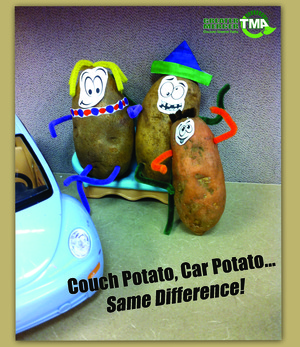Do you get GMTMA’s monthly newsletter delivered to your inbox? If not, sign up today! Here’s our latest issue:
**********
|
Get Off Your Spud!
|
||
Sitting — whether it’s on the couch or in your car – leads to all kinds of negative health effects. Will you get off your spud and join the Tater Family as they journey from Car Potato to Active Spud in celebration of National Heart Month? Be sure to subscribe to our blog and follow us on Facebook and Twitter to keep up with the active transportation adventures of the Spud Family all month long!
 |
||
|
Celebrate American Heart Month: Get Moving |
||
| February is American Heart Month. Did you know that the health of your heart can be directly linked to how you get around? Studies show that in addition to being a real downer, long commutes can be linked to bad health.But many people can turn their commutes into heart-healthy ones. Many studies have found that people who walk or bike to work are not only happier, but also healthier. People who ride a bike or walk to work are more fit, less overweight, and have healthier triglyceride levels, blood pressure, and insulin levels, according to a recent study in the Archives of Internal Medicine. Additionally, a recent Governing review of census and CDC data found that communities where more residents walk or bike to work boast significantly healthier weights. The analysis of 2010 statistics for 126 metropolitan areas finds these communities are strongly correlated with higher numbers of residents who are neither obese nor overweight.Other perks of walking and biking to work include:
If you live within five miles of your job, try an “active commute”. Here are some tips to get you started:
Even if you can’t commute by foot or bike — there are ways to get healthy by moving more and, where possible, tweaking your commute. If you use public transportation, you can get off a stop or two early and walk or bike the rest of the way. This might also save you a little money. Or you can try to fit in physical activity in other parts of your day. Instead of sitting at your desk at lunch, go for a 30-minute walk. Keep sneakers in your car at all times so you’re always ready for a brisk walk! Want to learn more about how to change the way you get around, but don’t know where to start? GMTMA is here to help. Check out our Employer Services to learn about how we can help employers encourage their workforce to leave the cars at home; learn about our programs for commuters, including carpooling and vanpooling; check out our Community Programs and learn about how GMTMA can help your community implement a wide variety of policies and programs that improve safety, mobility and sustainability; get involved in our Safe Routes to School program, which helps kids and their parents get to school safely without driving; learn how to ride your bike more; or figure out ways to ride the bus or train more often. Contact GMTMA — we can help you, your office, or your school figure out alternative ways to get around.
Community Transit Services Shine in Hurricane Sandy’s Wake Hurricane Sandy wreaked havoc on our region’s transportation system; New Jersey Transit alone lost $100 million in trains and equipment during the storm, which includes damage to all 12 rail lines, which suffered flooding and some 630 downed trees. Among the hardest hit communities were those along the Jersey Shore, including the Ocean County communities in GMTMA’s region.But in spite of the transportation chaos after the storm, in some places, community transit systems played an important role by helping out people without access to an automobile or traditional bus and rail services.This article tells the stories of four county transportation agencies as they deal with evacuation and emergency transports in the week following the storm. Monmouth SCAT, Ocean RIDE, Atlantic County Transportation (ACT) and Cape May Fare Free transportation faced challenges unlike those presented by any previous storm, but they got the job done!
|
